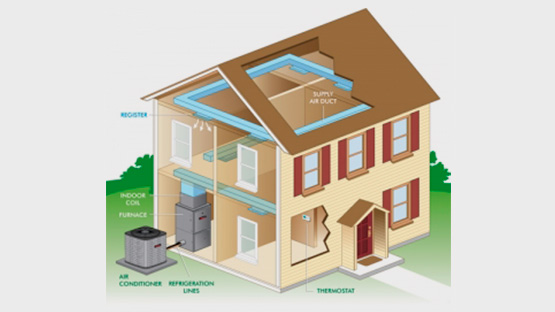Check The Thermostat
This is the first place to look for a problem. It's quite possible that you don't have furnace trouble at all. The furnace won't operate unless it receives the command from the thermostat.
Make sure your thermostat wiring isn't broken anywhere along the line to the furnace. If you happen to discover any breaks, a simple splice that's wrapped with electrical tape will provide a temporary fix.
Remove the thermostat cover and carefully inspect for loose wiring. Your thermostat should be sitting level and securely attached. Remove any dust.
Make Sure The Furnace Is Powered
You don't want to pay for a furnace repair call if all that's needed is the flipping of a switch. Make sure the power switch to the furnace is 'on'. It looks like any typical wall switch and you'll find it located either on the furnace or on a nearby wall.

Be sure the circuit breaker line or the fuse to the furnace is delivering power.
Check the panel that sits over the blower motor. The furnace can't operate if it isn't securely closed. When it's in the proper position, it depresses a switch that allows it to work.
Change The Furnace Filters
The number one cause of furnace operating failure is clogged filters that cause overheating and premature shut-off. You'll know this is the problem if the blower motor is running but there's no heat coming through.
Check the gas furnace manual to locate the filter, learn how to properly remove it and select the replacement size/type.
Please note that a clogged, soot-laden filter leads to a filthy heat exchanger as well. Efficiency is greatly reduced and the furnace can sustain life-shortening damage. Replace cheap filters every month during the heating season. Inspect pleated filters every few months and change them as needed.
Is The Gas Turned On?
Don't overlook this step just because it seems too incredible. It's possible that someone deliberately turned the gas valve into the 'off' position for some reason and then forgot to turn it back on.
If your gas line has a levered handle, be sure it's positioned parallel to the pipe. If it's perpendicular, it's turned 'off'.
An older furnace probably has a pilot light. Remove the panel on the front of the gas furnace and then remove the cover to the burner. Visually check to see of the pilot is lit.
Flush The Drain Lines
Furnaces that are highly efficient drain gallons of water every day. Make sure there's no mold or dirt build-up that's shutting your furnace down.
Cleaning the drain hose is easy. Simply remove the hose, fill it with water that contains 25% bleach and let it sit for several minutes. Flush it out and put it back into place.
Check For Restricted Air Flow
When your furnace is running but some rooms remain cold, be sure that any air registers are fully open.
Check the ductwork for gaps or breaks. Seal them with a special duct tape that's made of metal.
While you're at it, be on the lookout for any levers that might be jutting out from the ductwork. These dampers should be in the 'open' position.
Check For Blocked Intake Or Exhaust Vents
This is applicable if your gas furnace is vented on the side of your house. Make sure the vents are completely clear of any debris.
Similarly, if there's a heat pump, check for debris build-up near the outside compressor fins.
While these DIY furnace repair tips can save you money, there will be times when you need to call on a professional gas furnace repair specialist. Don't be left out in the cold. Put our reliable, courteous, certified heating technicians to work for you.


 HABLAMOS ESPAÑOL
HABLAMOS ESPAÑOL